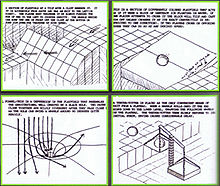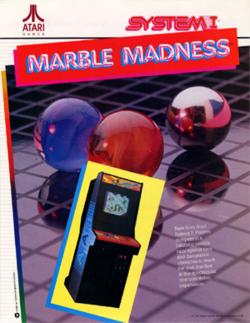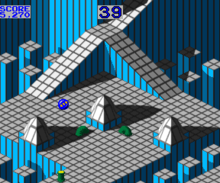Marble Madness
The digital 80's
I loved games, and in my infancy I used to be an "adult playing observer", passing hours watching people inserting 25 peseta coins for additional lifespan in Gauntlet, or trying to consume all Out Run's in-game melodies and the colorful USA-wide scroll. Defender, Space Invaders, Galaxian or Donkey Kong are the first ones I remember, full of charm, in bars, mini-golf resources, or swimming pools near León, with a delicious smell to tapas.
Marble Madness is an arcade video game designed by Mark Cerny, and published by Atari Games in 1984. It is a platform game in which the player must guide an onscreen marble through six courses, populated with obstacles and enemies, within a time limit. The player controls the marble by using a trackball. Marble Madness is known for using innovative game technologies. It was Atari's first to use the Atari System 1 hardware and to be programmed in the C programming language. The game was also one of the first to use true stereo sound; previous games used either monaural sound or simulated stereo.
In designing the game, Cerny drew inspiration from miniature golf, racing games, and artwork by M. C. Escher. He aimed to create a game that offered a distinct experience with a unique control system. Cerny applied a minimalist approach in designing the appearance of the game's courses and enemies. Throughout development, he was frequently impeded by limitations in technology and had to forgo several design ideas.
Upon its release, Marble Madness was commercially successful, becoming a profitable arcade game. Praise among critics focused on the game's difficulty, unique visual design, and stereo soundtrack. The game was ported to numerous platforms and inspired the development of other games. A sequel was developed and planned for release in 1991, but canceled when location testing showed the game could not succeed in competition with other titles.
Keywords:
3D computer graphics
Amiga
Apple IIGS
Arcade game
Arcade system board
Assembly language
Atari Games
Atari System
Atari System 1
Ballance
Battlezone (1980 video game)
Beat 'em up
C (programming language)
Cathode ray tube
Central Processing Unit
Central processing unit
Collectable
Collision detection
Compiler
Computer simulation
Computing platform
D-pad
Dennis Publishing
Dragon (magazine)
Duophonic
Edge (magazine)
Electric Dreams Software
Electrohome
Electronic Arts
Focus group
Frequency modulation synthesis
Gamasutra
Game Boy
Game Boy Advance
Game controller
Game designer
GameSpot
GameTrailers
Guinness World Records
Gyroscope (video game)
HarperCollins
Heightmap
Hertz
I, Robot (arcade game)
IGN
Imagine Publishing
International Standard Book Number
Interpreter (computing)
Isometric projection
Killer List of Videogames
Krome Studios Melbourne
Linux
Liquid crystal display
M. C. Escher
MOS Technology 6502
Mac OS X
Marble Blast Gold
Marble Madness
Mark Cerny
Michael Jackson's Thriller
Microsoft Windows
Midway Arcade Treasures
Midway Games
Miniature golf
Minigame
Minimalism
Mobile phone
Moby Games
Monaural
Motorola 68010
Multiplayer video game
Neverball
Nintendo
Nintendo Entertainment System
Nintendo Power
North American video game crash of 1983
POKEY
Pac-Man
Paul Weir
Personal computer
Pixel
Platform game
Porting
Racing video game
Random House
Random-access memory
Rare Ltd.
Raster graphics
Ray tracing (graphics)
Read Only Memory
Retro Gamer
Running Press
ScrewAttack
Sega Mega Drive
Snake Rattle 'n' Roll
Sound chip
Spatial anti-aliasing
Spindizzy (video game)
Sprite (computer graphics)
Stereophonic sound
Street Fighter II
Super Monkey Ball
Super Monkey Ball (series)
Switchball
Synchronization
Synthesizer
TSR, Inc.
Tiger Electronics
Trackball
Video game
Video game developer
Video game genres
Video game music
Video game publisher
WMS Industries
Yamaha Corporation
Yamaha DX7
Yamaha YM2151
Your Sinclair
ZX Spectrum
Content extracted from Wikipedia, where you can find its license details.
Ignacio Javier Gómez Rodríguez (igjav). OS developer. Naive power.





